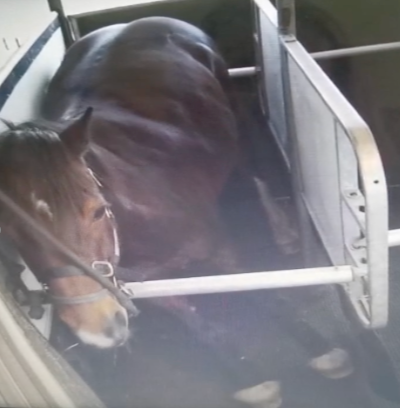Loading:
Which way do horses prefer to travel in a trailer?
I conducted a study with five 14.2hh horses with differences in age and travelling experience. The aim of the study was to compare data to determine a preferred method of travelling in horses.

Carley O'Callaghan (2021)
Introduction...
Understanding how horses prefer to travel plays a crucial part in understanding why a horse may be reluctant to load. We know we can train a horse to want to load but some horses may then be reluctant to load again once they have travelled, and this is what has intrigued me to complete this project.
If you are having loading issues, whether it is at home or away, I can help you. This is one of my most popular call outs, often the horse loads quicker when I am there, why do you think this is? It is because the owner is usually more relaxed when another person arrives to help, it is a relief to them that help is there. If you would like to know more about behaviour, then check out this other great article:


Equipment used:
It is important to note that horses wore headcollars when the partition was in, and removed when the partition was out to minimise injury risks and hazards.
- Appropriate towing vehicle
- Correctly fitted Dually headcollar
- 20 foot long line
- 6 foot lead rope
- Poll guard during loading
- Boots and bandages if comfortable
- GoPro Camera
- PPE including hat, gloves and yard boots
Safety:
Each horse travelled without forage for a fair result. If forage was in the trailer when the partition was out, I believe this may have impacted on the results, as the horse may have wanted to face whichever way the forage was. All horses were brought in from their field two hours before travelling.
- Vehicle serviced and checks prior to travel
- Horses loaded in Menage to reduce injury risks
- Coiled lead rope to reduce injury risks
- PPE worn during handling
- Assistance with jockey door during loading
- Headcollars removed when partition was out
- Monitoring horses using camera during travel
Taran's loading story
Taran 14.2hh, 20-year-old Section D Cob gelding who has travelled numerous times, always with the partition in.


Partition in...
As soon as we started the journey, Taran started leaning to the side of the trailer and was shaking. He was leaning so excessively at some points that it caused him to slip. Between two and four minutes whilst travelling at 10mph, he slipped and actually went down in the trailer. Thankfully this only happened once throughout the journey and he got himself up as quickly as he went down. Things could have turned out a lot worse. This must have caused him a lot of distress. The concerning part of this for me, is that I couldn’t feel this from the driver’s seat of the vehicle. Throughout the journey, he continued to lean and shake, showing very few signs of relaxed behaviour. Overall this appeared to have been a terrible experience for Taran.
Partition out...
Now I must admit, I expected Taran to be reluctant to load for this journey, but walked straight onto the trailer without hesitation. Possibly this was a sign of learned helplessness? As we set off, it took him a short while to adjust. He leaned and was shaking much less than with the partition in, but soon these behaviours completely disappeared. Taran spent most of the journey with his head lowered and I think this helped to calm him. Overall, Taran had a much better journey with the partition out. Taran spent more of the journey facing forward than he did backwards. He turned a number of times and found standing at an angle in the trailer most comfortable.
